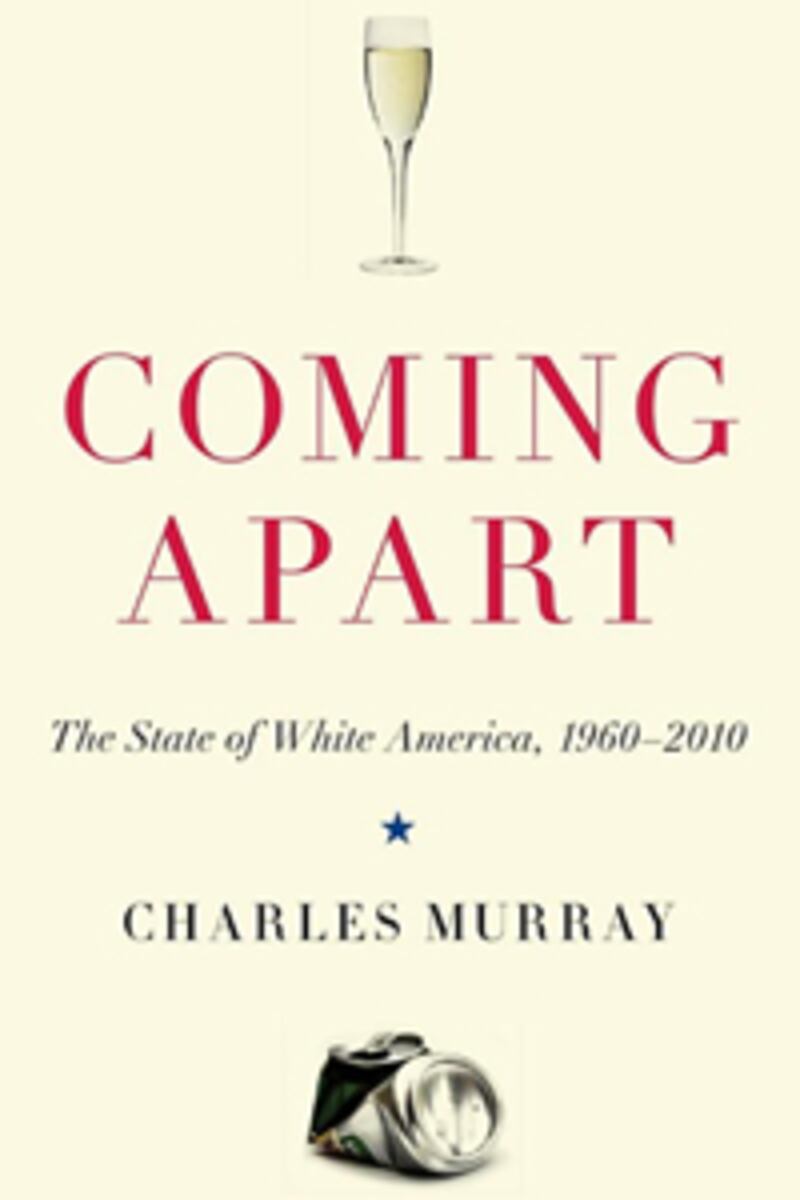
This is Part 1 of a review of Charles Murray's new book "Coming Apart." Click here to read Part 2, Click here to read Part 3, Click here to read Part 4, Click here to read Part 5.
Charles Murray's Coming Apart: The State of White America, 1960-2010 is an important book that will have large influence. It is unfortunately not a good book—but its lack of merit in no way detracts from its importance. If anything, the book's flaws add to its power, by enhancing the book's appeal to the audience for whom it is intended. Coming Apart is an important book less because of what it says than because of what it omits; less for the information it contains than for the uses to which that information will be put.
To understand what Murray does in Coming Apart, imagine this analogy:
A social scientist visits a Gulf Coast town. He notices that the houses near the water have all been smashed and shattered. The former occupants now live in tents and FEMA trailers. The social scientist writes a report:
The evidence strongly shows that living in houses is better for children and families than living in tents and trailers. The people on the waterfront are irresponsibly subjecting their children to unacceptable conditions.
When he publishes his report, somebody points out: "You know, there was a hurricane here last week." The social scientist shrugs off the criticism with the reply, "I'm writing about housing, not weather."
Coming Apart details the social problems that have overtaken the poorer half of the white American population over the past generation. This population is less committed to the workforce than its parents and grandparents were. It has more trouble with the law. It has more children outside marriage.
None of this information comes as news to anybody. Social observers have been making these points for years. The novelty of Coming Apart is Charles Murray's remarkable—and telltale—uncuriosity as to why any of this might be happening.
I should probably pause to note here that Charles Murray and I have had our personal innings. When I was sacked from the American Enterprise Institute in 2010, Murray posted a blog insisting that I had been fired—not for writing this blogpost—but for laziness. (To which the answer could only be, borrowing from the Duke of Wellington, if you can believe that, you will believe anything.)
However, this unpleasantness has never prevented me from recognizing the merit of Murray's early scholarly work. In this interview, conducted two months after Murray's comments, I cited his first book, Losing Ground, as one of the outstanding works of the pioneering era of conservative thought. It would sincerely give me pleasure to be able to say the same of Coming Apart.
I cannot, and I doubt that anybody other than people strongly pre-committed to endorse Murray's work will say so either.
Here is the book's one discussion of the idea that the social troubles of lower-class America might be related to the (rather notorious) economic troubles of lower-class America. It's such a revealing and fascinating statement that I will quote at length, both on the passage's own merits and to ensure that the argument is given its full context.
A natural explanation for the numbers I have presented is that the labor market got worse for low-skill workers from 1960 to 2008. More [working-class white] men worked short hours because they couldn't get work for as many hours as they wanted; more of them were unemployed because it was harder for them to get jobs; more them left the labor market because discouraged by the difficulty of finding jobs.
In one respect, the labor market did indeed get worse for [working-class white] men: pay. Recall figure 2.1 at the beginning of the book, showing stagnant incomes for people below the 50th income percentile.** High-paying unionized jobs have become scarce and real wages for all kinds of blue-collar jobs have been stagnant or falling since the 1970s. But these trends don't explain why [working-class white] men in the 2000s worked fewer jobs, found it harder to get jobs than other Americans did, and more often dropped out of the labor market than they had in the 1960s. On the contrary: Insofar as men need to work to survive - an important proviso - falling hourly income does not discourage work.
Put yourself in the place of a [working-class white] man who is at the bottom of the labor market, qualified only for low-skill jobs. You may wish you could make as much as your grandfather made working on a General Motors assembly line in the 1970s. You may be depressed because you've been trying to find a job and failed. But if a job driving a delivery truck, or being a carpenter's helper, or working on a cleaning crew for an office building opens up, why would a bad labor market for blue-collar jobs keep you from taking it? As of 2009, a very bad year economically, the median hourly wage for drivers of delivery trucks was $13.84; for carpenter's helpers, $12.63; for building cleaners, $13.37. That means $505 to $554 for a forty-hour week, or $25,260 to $27,680 for a fifty-week year. Those are not great incomes, but they are enough to be able to live a decent existence - almost twice the poverty level even if you are married and your wife doesn't work. So why would you not work if a job opening landed in your lap? Why would you not work a full forty hours if the hours were available? Why not work more than forty hours?
Murray is baffled that a collapse in the pay and conditions of work should have led to a decline in a workforce's commitment to the labor market.
His book wants to lead readers to the conclusion that the white working class has suffered a moral collapse attributable to vaguely hinted at cultural forces. Yet he never specifies what those cultural forces might be, and he presents no evidence at all for a link between those forces and the moral collapse he sees.
In an interview with the New York Times, Murray is more specific—but no more precise—in his analysis:
The ’60s were a disaster in terms of social policy. The elites put in place a whole set of reforms which I think fundamentally changed the signals and the incentives facing low-income people and encouraged a variety of trends that soon became self-reinforcing.
The '60s. Of course. But which reforms are the ones that Murray has in mind? He does not say, and I think I can understand why he does not say: because once you spell out the implied case here, it collapses of its own obvious ludicrousness.
Let me try my hand:
You are a white man aged 30 without a college degree. Your grandfather returned from World War II, got a cheap mortgage courtesy of the GI bill, married his sweetheart and went to work in a factory job that paid him something like $50,000 in today's money plus health benefits and pension. Your father started at that same factory in 1972. He was laid off in 1981, and has never had anything like as good a job ever since. He's working now at a big-box store, making $40,000 a year, and waiting for his Medicare to kick in.
Now look at you. Yes, unemployment is high right now. But if you keep pounding the pavements, you'll eventually find a job that pays $28,000 a year. That's not poverty! Yet you seem to waste a lot of time playing video games, watching porn, and sleeping in. You aren't married, and you don't go to church. I blame Frances Fox Piven.
How you can tell a story about the moral decay of the working class with the "work" part left out is hard to fathom.
But that's not the limit of Murray's uncuriosity. There are two other limits, both striking, and both contained in the book's subtitle. The first is the word "America."
Coming Apart contains not a single reference to the world outside the United States. Yet the decline in the life prospects of the less-skilled is not a uniquely American phenomenon.
Across the developed world, we see the wages of the bottom half (and in some cases more than half) have stagnated, even as gains have accrued to the top 20%, bigger gains to the top 5%, and the biggest gains to the top 1%.
This trend toward inequality varies from country to country—more extreme in the United Kingdom, less extreme in Germany. The subsequent destabilization of working-class social life likewise varies from country to country. But if the trend is global, the cause must be global too. Yet that thought does not trouble Murray.
The second limit to Murray's curiosity is revealed by his time limit: "1960 to 2010." Suppose instead Murray had looked at the whole past century, rather than just half of it: 1910-2010. He'd have found a different and even more suggestive trend: a white working class that became more law-abiding, more temperate, more familial and more civic-minded between 1910 and 1960 and then ever less after about 1970.
Which would raise the question: So if "the 1960s" are responsible for the post-1970 deterioration, what was responsible for the pre-1960 improvement?
Murray does not want to face this question, because it might require him to reconsider elements of his ideology—something he declares himself unwilling to consider.
Data can bear on policy issues, but many of our opinions about policy are grounded on premises about the nature of human life and human society that are beyond the reach of data. Try to think of any new data that would change your position on abortion, the death penalty, legalization of marijuana, same-sex marriage or the inheritance tax. If you cannot, you are not necessarily being unreasonable.
So it has been with the evidence I have presented. A social democrat may see in parts 1 and 2 a compelling case for the redistribution of wealth. A social conservative may see a compelling case for government policies that support marriage, religion, and traditional values. I am a libertarian, and see a compelling case for returning to the founders' conception of limited government.
Three answers:
1) It's historically wrong to describe the "founders' conception of limited government" as if there existed some group called "the founders" who broadly agreed a vision of government that more or less corresponded to contemporary libertarianism.
2) As a matter of fact, if you announce that there can exist no possible information that might change your mind about abortion, the death penalty, marijuana, same-sex marriage, and the inheritance tax, then yes you are an unreasonable person—or anyway, an unreasoning one. I've changed my mind about same-sex marriage as experience has dispelled my fears of the harms from same-sex marriage. If somebody could prove to me that marijuana was harmless or that legalization would not lead to an increase in marijuana use, I'd change my mind about marijuana legalization. And so on through the list.
3) But here's the most important point of all. I tramped through a lot of the same research that Charles Murray presents here when I wrote my history of the 1970s, How We Got Here.
As I looked backward and forward in time, however, I had to face this awkward fact: America became more culturally stable between 1910 and 1960 as it became less economically and socially libertarian. As it became more economically and socially libertarian after 1970, America became culturally less stable:
"The greatest generation was also the statist generation. Like them or loathe them, the middle decades of the twentieth century were an entirely anomalous period in American history. Never had the state been so strong, never had people submitted as uncomplainingly, never had the country been more economically equal, never had it been more ethnically homogeneous, seldom was its political consensus more overpowering."
Murray nostalgically regrets the lost America of his 1950s Midwestern boyhood. But to describe in any true way how that America was lost would require a reckoning of how that America was made. Unwilling, as he acknowledges, to submit his politics to the check of uncongenial evidence, Murray prefers to avoid encountering the evidence that might shake his politics.
Let me instance another example of the unwillingness. In the first long quoted passage from Coming Apart, I asterisked one of Murray's statistical claims, a claim stating that wages have stagnated for the bottom 50% of the white work force. That claim is true if you draw your line, as Murray does, beginning in 1960. But put your thumb on the left side of the chart, and start drawing the line beginning in 1970. Then you notice that median wages have stagnated for the whole bottom 75%—and that the median wage only begins to show significant improvement over time when you look at the top 5%.
That number points in a very different direction from the one in which Murray would like to lead his audience. And this kind of polemical use of data is one—but only one—of the things that discredits Coming Apart as an explanation of the social trouble of our times.
As for the other things ... they must await a second post, dealing with Murray's treatment of what he calls the new upper class.
—MORE TO COME—






